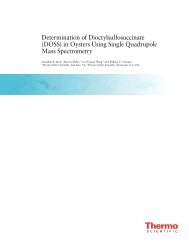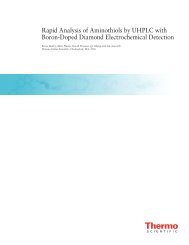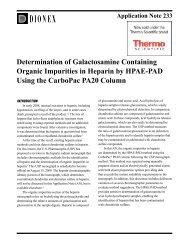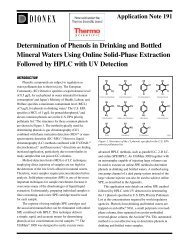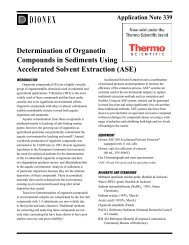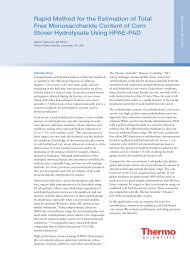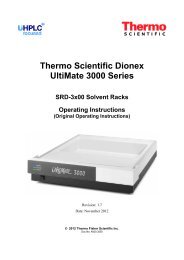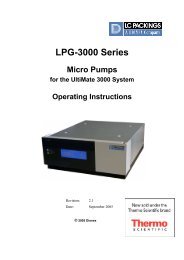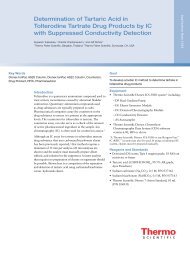AN 276: Direct Determination of Fluoroacetate in Water - Dionex
AN 276: Direct Determination of Fluoroacetate in Water - Dionex
AN 276: Direct Determination of Fluoroacetate in Water - Dionex
You also want an ePaper? Increase the reach of your titles
YUMPU automatically turns print PDFs into web optimized ePapers that Google loves.
<strong>Direct</strong> <strong>Determ<strong>in</strong>ation</strong> <strong>of</strong> <strong>Fluoroacetate</strong> <strong>in</strong><br />
<strong>Water</strong> by IC-MS<br />
Marcus Miller and William Schnute<br />
Thermo Fisher Scientific, San Jose, CA, USA<br />
Introduction<br />
<strong>Fluoroacetate</strong> (FA, compound 1080) is a strong metabolic<br />
poison commonly used as a rodenticide and predacide. 1<br />
Fluoroacetic acid is also an <strong>in</strong>termediate metabolite <strong>of</strong><br />
many compounds, such as anticancer drugs 5-fluorouracil<br />
and fluoroethyl nitrosourea. <strong>Fluoroacetate</strong> is <strong>in</strong>expensive,<br />
simple to synthesize, tasteless, and highly soluble <strong>in</strong> water.<br />
Due to the high level <strong>of</strong> toxicity when <strong>in</strong>gested, 2 and no<br />
known antidotes, its use has been banned or restricted <strong>in</strong><br />
many countries. The United States Environmental<br />
Protection Agency (U.S. EPA) has placed sodium fluoroacetate<br />
<strong>in</strong> Toxicity Category I <strong>in</strong>dicat<strong>in</strong>g the highest degree<br />
for acute oral toxicity. It is therefore crucial to develop a<br />
method for determ<strong>in</strong>ation <strong>of</strong> fluoroacetic acid.<br />
Analyses for fluoroacetate have been previously performed<br />
us<strong>in</strong>g several methods, <strong>in</strong>clud<strong>in</strong>g gas<br />
chromatography, 3 HPLC, 4 and fluoride ion selective<br />
electrode. 5 Many <strong>of</strong> these techniques relied upon<br />
derivatization prior to analysis 6-8 and lacked adequate<br />
sensitivity for low-level detection. Use <strong>of</strong> chromatographic<br />
separation with selected ion monitor<strong>in</strong>g (SIM) mass<br />
spectrometry (MS) detection affords the opportunity to<br />
reliably identify this compound at trace levels <strong>in</strong> water<br />
samples.<br />
This study undertook an <strong>in</strong>vestigation to quantify<br />
fluoroacetate without prior derivatization or sample<br />
pretreatment. An ion chromatography (IC) method was<br />
developed with an MS detector. A fortified dr<strong>in</strong>k<strong>in</strong>g water<br />
matrix was prepared follow<strong>in</strong>g U.S. EPA guidel<strong>in</strong>es and<br />
used to challenge the separation and robustness <strong>of</strong> the<br />
method. Samples <strong>of</strong> fortified dr<strong>in</strong>k<strong>in</strong>g water spiked with<br />
the analyte were <strong>in</strong>jected directly. Monitor<strong>in</strong>g the<br />
mass-to-charge ratio (m/z) <strong>in</strong> SIM mode on a s<strong>in</strong>gle<br />
quadrupole <strong>in</strong>strument allowed for highly sensitive and<br />
selective analysis. Method performance parameters such<br />
as l<strong>in</strong>earity, calibration range, precision, accuracy, and<br />
detection limits were determ<strong>in</strong>ed.<br />
Experimental<br />
Equipment<br />
• Thermo Scientific <strong>Dionex</strong> ICS-3000 Reagent-Free IC (RFIC ) system* <strong>in</strong>clud<strong>in</strong>g:<br />
– DP Dual Pump<br />
– EG Eluent Generator (KOH)<br />
– CR-ATC trap cartridge<br />
– DC Detector Compartment<br />
– CD Conductivity Detector<br />
– AS Autosampler<br />
• Thermo Scientific MSQ Plus s<strong>in</strong>gle quadrupole mass<br />
spectrometer<br />
• Thermo Scientific <strong>Dionex</strong> AXP Auxiliary Pump<br />
• Thermo Scientific <strong>Dionex</strong> Chromeleon 6.8, SR10<br />
Chromatography Data System s<strong>of</strong>tware<br />
*This application can also be performed us<strong>in</strong>g the <strong>Dionex</strong><br />
ICS-5000 system.<br />
Application Note <strong>276</strong>
2<br />
Chromatographic Conditions<br />
IC System<br />
Columns: Thermo Scientific <strong>Dionex</strong> IonPac AG24 guard column, 2.1 × 50 mm<br />
<strong>Dionex</strong> IonPac AS24 column, 2.1 × 250 mm<br />
Mobile Phase: Electrolytically generated KOH gradient<br />
Gradient: Time (m<strong>in</strong>) Conc. (mM)<br />
0 5<br />
20 5<br />
20.1 80<br />
30.1 80<br />
30.2 5<br />
37.2 5<br />
Flow Rate: 0.25 mL/m<strong>in</strong><br />
Temperature: 15 °C<br />
Inj. Volume: 100 µL (full loop)<br />
Detection: Suppressed conductivity: Thermo Scientific <strong>Dionex</strong> ASRS 300 Anion Self-Regenerat<strong>in</strong>g<br />
Suppressor MS Parameters<br />
2 mm, external water mode<br />
(0.5 mL/m<strong>in</strong>)<br />
ESI: Negative ion<br />
SIM Scan: –77.0 m/z with 0.7 m/z span,<br />
dwell time 1.0 s<br />
N Pressure: 2 80 psi<br />
Probe Temp.: 450 °C<br />
Needle Voltage: 2 kV<br />
Cone Voltage: 45 V<br />
Plumb a divert valve after the CD detector to allow<br />
other compounds to be directed away from the MS after<br />
the elution <strong>of</strong> the analytes <strong>of</strong> <strong>in</strong>terest. Add a flow <strong>of</strong><br />
0.1 mL/m<strong>in</strong> <strong>of</strong> CH 3 CN via a low-volume mix<strong>in</strong>g tee prior<br />
to the MS to aid with the thermally assisted pneumatic<br />
nebulization <strong>of</strong> the electrospray ionization (ESI) source.<br />
<strong>Water</strong><br />
<strong>Water</strong><br />
<strong>Dionex</strong> ICS-3000 Pump 2<br />
500 µL/m<strong>in</strong><br />
<strong>Dionex</strong> ICS-3000<br />
Pump 1<br />
250 µL/m<strong>in</strong><br />
Eluent<br />
Generator<br />
Waste<br />
Figure 1. Schematic <strong>of</strong> an RFIC-MS system.<br />
Divert Valve<br />
(See Figure 1.)<br />
Trap Column<br />
SRS *<br />
Guard<br />
Time (m<strong>in</strong>) Position<br />
0 To Waste<br />
0.1 To MS<br />
20 To Waste<br />
*Thermo Scientific <strong>Dionex</strong> SRS <br />
Self-Regenerat<strong>in</strong>g Suppressor<br />
Signals<br />
Sodium <strong>Fluoroacetate</strong><br />
Figure 2. Structure <strong>of</strong> sodium fluoroacetate.<br />
F<br />
MSQ Plus<br />
O<br />
O – Na +<br />
Preparation <strong>of</strong> Solutions and Reagents<br />
• Sodium fluoroacetate (CAS 62-74-8, Sigma-Aldrich<br />
P/N 36755). Figure 2 shows the chemical structure.<br />
• Acetonitrile (HPLC grade, Burdick & Jackson<br />
P/N AH015-4).<br />
Conductivity<br />
Detector<br />
Divert Valve<br />
Micro<br />
Tee<br />
Waste<br />
Acetonitrile<br />
AXP Pump<br />
100 µL/m<strong>in</strong><br />
28101<br />
• Deionized (DI) water, 18.2 MΩ-cm resistance, produced<br />
by a Millipore water station.<br />
• Salts to make a synthetic dr<strong>in</strong>k<strong>in</strong>g water (DW),<br />
<strong>in</strong>clud<strong>in</strong>g:<br />
– 250 mg/L sodium chloride (NaCl, CAS 7647-14-5,<br />
J.T. Baker P/N 4058-05)<br />
– 250 mg/L sodium sulfate (Na 2 SO 4 , CAS 7757-82-6,<br />
EM Science P/N SX0760-1<br />
– 150 mg/L sodium bicarbonate (NaHCO 3 ,<br />
CAS 144-55-8, EM Science P/N SX0320-1)<br />
– 30 mg/L sodium nitrate (NaNO 3 , CAS 7631-99-4,<br />
Sigma-Aldrich P/N 22,134-1)<br />
27788
Area [counts*m<strong>in</strong>]<br />
350,000<br />
300,000<br />
250,000<br />
200,000<br />
150,000<br />
100,000<br />
10,000<br />
7500<br />
5000<br />
2500<br />
50,000<br />
0<br />
0 100 200<br />
–175<br />
0 2.5 5 7.5 10 12<br />
ppb (ng/mL)<br />
300 400 500 600<br />
ppb (ng/mL)<br />
28102<br />
Prepare a total <strong>of</strong> 250 mL <strong>of</strong> synthetic DW us<strong>in</strong>g the<br />
above recipe. Prepare a primary stock solution <strong>of</strong> FA at<br />
1000 µg/mL (ppm) <strong>in</strong> DI water. Prepare work<strong>in</strong>g stock<br />
solutions by dilut<strong>in</strong>g the primary stock solutions <strong>in</strong>dividually<br />
<strong>in</strong>to DI and DW at 10 ppm and 100 ppb<br />
concentrations. Use these to subsequently prepare<br />
calibration standards and spiked DW samples.<br />
Calibration<br />
Prepare FA standards <strong>in</strong> clean DI water at 12 concentrations:<br />
0.1, 0.2, 0.5, 1, 2, 5, 10, 20, 50, 100, 200, and<br />
500 ppb. Full loop <strong>in</strong>jections <strong>of</strong> 100 µL yield a total<br />
amount <strong>of</strong> 10 pg to 50 ng loaded on column (Figure 3).<br />
Prepare samples <strong>in</strong> fortified DW spiked at the same<br />
12 levels as the DI standards. To obta<strong>in</strong> an estimate <strong>of</strong> the<br />
limits <strong>of</strong> detection (LOD), analyze a 2 ppb standard <strong>in</strong> DI<br />
water and a 2 ppb concentration <strong>in</strong> DW each seven times.<br />
Results and Discussion<br />
Chromatography<br />
As shown <strong>in</strong> Figure 4, FA was reta<strong>in</strong>ed well on the IonPac<br />
AS24 column. A retention factor (k') <strong>of</strong> 8 was observed,<br />
<strong>in</strong>dicat<strong>in</strong>g sufficient retention to separate the target from<br />
matrix <strong>in</strong>terferences. The <strong>Dionex</strong> IonPac AS24 column<br />
was chosen for its high capacity, which allows large<br />
<strong>in</strong>jection volumes and improves detection limits, especially<br />
<strong>in</strong> high ionic strength samples. Although the analyte eluted<br />
at ~12.5 m<strong>in</strong>, the complete run was 37.2 m<strong>in</strong> long. This<br />
allowed strongly reta<strong>in</strong>ed ions to be washed <strong>of</strong>f the<br />
column with a strong eluent before return<strong>in</strong>g and<br />
equilibrat<strong>in</strong>g to start<strong>in</strong>g conditions before the next sample<br />
<strong>in</strong>jection. This improved method ruggedness when<br />
analyz<strong>in</strong>g the fortified DW samples.<br />
Mass Spectrometry<br />
The aim <strong>of</strong> the study was to develop a selective and<br />
sensitive method for direct analysis <strong>of</strong> trace levels <strong>of</strong><br />
fluoroacetic acid <strong>in</strong> environmental water samples. The<br />
mass spectrometer provides <strong>in</strong>herent selectivity based on<br />
m/z, and operation <strong>in</strong> SIM mode provides <strong>in</strong>creased<br />
sensitivity. Under IC conditions, the FA showed a strong<br />
deprotonated molecular ion at 77.0 m/z <strong>in</strong> negative ESI<br />
mode. The ionization parameters were optimized <strong>in</strong>dependently,<br />
start<strong>in</strong>g with vary<strong>in</strong>g cone voltage, then needle<br />
Area [counts*m<strong>in</strong>]<br />
Figure 3. Calibration curve <strong>of</strong> fluoroacetate, 0.1–100 ppb <strong>in</strong> DI water.<br />
5500<br />
counts<br />
<strong>Fluoroacetate</strong><br />
S/N=36.1<br />
0<br />
0 2 4 6 8 10 12 14 16 18 20<br />
M<strong>in</strong>utes<br />
28104<br />
Figure 4. SIM chromatogram <strong>of</strong> –77 m/z fluoroacetate at 2 ppb <strong>in</strong> DI water.<br />
18,000<br />
counts<br />
<strong>Fluoroacetate</strong><br />
S/N=32<br />
0<br />
–2000<br />
0 2 4 6 8 10 12 14 16 18 20<br />
M<strong>in</strong>utes<br />
28106<br />
Figure 5. SIM chromatogram <strong>of</strong> –77 m/z, 2 ppb fluoroacetate <strong>in</strong> dr<strong>in</strong>k<strong>in</strong>g<br />
water (DW).<br />
voltage, and f<strong>in</strong>ally probe temperature. Optimal parameters<br />
are recorded <strong>in</strong> the Chromatographic Conditions<br />
section. The scan dwell time was optimized to give good<br />
peak shape given the chromatographic width <strong>of</strong> the peak.<br />
Longer dwell times result <strong>in</strong> greater signal accumulation<br />
and better S/N but reduce the number <strong>of</strong> po<strong>in</strong>ts across the<br />
chromatographic peak. Narrow chromatographic peaks<br />
require shorter dwell times to ma<strong>in</strong>ta<strong>in</strong> good peak shape.<br />
Note that optimal parameters for MS analysis are<br />
<strong>in</strong>strument- and compound-dependent, and analysts<br />
wish<strong>in</strong>g to repeat these experiments are advised to<br />
evaluate all acquisition parameters to determ<strong>in</strong>e optimal<br />
values for different systems and analytes.<br />
Method Performance<br />
Selectivity for FA was established through the use <strong>of</strong> a<br />
SIM scan on the molecular ion, and when comb<strong>in</strong>ed with<br />
chromatographic retention time, ensured that the<br />
FA was be<strong>in</strong>g accurately identified. Carryover was<br />
evaluated by <strong>in</strong>ject<strong>in</strong>g sample blanks (DI water) after a<br />
500 ppb standard <strong>in</strong>jection. No detectable peak was<br />
observed at the specific retention time. A quadratic curve<br />
best fit the calibration data because high concentrations<br />
contributed to saturation effects <strong>of</strong> the MS detector.<br />
Accuracy was calculated as observed amount/specified<br />
amount × 100%. Across the range from 1 ppb to 500 ppb,<br />
accuracy was ±15%, with most concentrations observed<br />
with<strong>in</strong> 8% <strong>of</strong> expected. Recovery accuracy <strong>in</strong> DW was<br />
with<strong>in</strong> 10% across concentrations from 0.5 ppb to 200<br />
ppb (Figure 5 and Table 1). Run-to-run precision and<br />
accuracy were evaluated by seven replicate <strong>in</strong>jections <strong>of</strong> a<br />
3
low-level standard at 2 ppb. Method detection limit<br />
(MDL) was estimated us<strong>in</strong>g the standard deviation<br />
obta<strong>in</strong>ed from the seven replicates us<strong>in</strong>g the follow<strong>in</strong>g<br />
equation:<br />
MDL = S × t99%, n-1=6<br />
where S is the standard deviation and t is the Student’s t<br />
at 99% confidence <strong>in</strong>terval. Detection limits were<br />
calculated to be 0.3 ppb for FA <strong>in</strong> DI water, and 1.8 ppb<br />
<strong>in</strong> fortified DW. This is better than reported results for GC<br />
analyses that require ethylation and solid-phase microextraction<br />
for analysis yet only achieved a 1 ppb detection<br />
limit <strong>in</strong> clean water and a 10 ppb detection limit <strong>in</strong> blood<br />
and plasma matrices. This method illustrates that good<br />
separation can be achieved with the IonPac AS24 column,<br />
and when comb<strong>in</strong>ed with the selectivity and sensitivity <strong>of</strong><br />
the MSQ Plus mass spectrometer, provides accurate<br />
identification and quantification.<br />
Table 1. Fortified dr<strong>in</strong>k<strong>in</strong>g water response.<br />
<strong>Fluoroacetate</strong><br />
Concentration<br />
(ppb)<br />
www.thermoscientific.com/dionex<br />
©2013 Thermo Fisher Scientific Inc. All rights reserved. ISO is a trademark <strong>of</strong> the International Standards Organization.<br />
Sigma-Aldrich is a registered trademark <strong>of</strong> Sigma-Aldrich Co. LLC. Burdick & Jackson is a registered trademark <strong>of</strong> Honeywell<br />
International Inc. Millipore is a registered trademark <strong>of</strong> Merck KGaA Darmstadt Germany. J.T. Baker is a registered trademark<br />
<strong>of</strong> Avantor Performance Materials, Inc. EM Science is a registered trademark <strong>of</strong> EMD Millipore. All other trademarks are the<br />
property <strong>of</strong> Thermo Fisher Scientific Inc. and its subsidiaries. This <strong>in</strong>formation is presented as an example <strong>of</strong> the capabilities <strong>of</strong><br />
Thermo Fisher Scientific Inc. products. It is not <strong>in</strong>tended to encourage use <strong>of</strong> these products <strong>in</strong> any manners that might <strong>in</strong>fr<strong>in</strong>ge<br />
the <strong>in</strong>tellectual property rights <strong>of</strong> others. Specifications, terms and pric<strong>in</strong>g are subject to change. Not all products are available<br />
<strong>in</strong> all countries. Please consult your local sales representative for details.<br />
Australia +61 3 9757 4486<br />
Austria +43 1 333 50 34 0<br />
Belgium +32 53 73 42 41<br />
Brazil +55 11 3731 5140<br />
Ch<strong>in</strong>a +852 2428 3282<br />
<strong>AN</strong>70478_E 01/13S<br />
Average<br />
(n = 3)<br />
Denmark +45 70 23 62 60<br />
France +33 1 60 92 48 00<br />
Germany +49 6126 991 0<br />
India +91 22 <strong>276</strong>4 2735<br />
Italy +39 02 51 62 1267<br />
RSD Recovery (%)<br />
0.10 ND — —<br />
0.20 ND — —<br />
0.50 0.47 12.52 93<br />
1.00 0.92 12.53 92<br />
2.00 1.51 43.64 98<br />
5.00 4.96 7.55 99<br />
10.00 9.52 15.97 95<br />
20.00 20.64 20.46 103<br />
50.00 53.25 18.17 107<br />
100.00 89.96 10.74 90<br />
200.00 216.42* 12.25 108<br />
500.00<br />
*Average <strong>of</strong> two analyses<br />
395.89 6.68 79<br />
**n=10 (3 plus 7 LOD measurements)<br />
Japan +81 6 6885 1213<br />
Korea +82 2 3420 8600<br />
Netherlands +31 76 579 55 55<br />
S<strong>in</strong>gapore +65 6289 1190<br />
Sweden +46 8 473 3380<br />
Conclusion<br />
Excellent recovery and detection <strong>of</strong> FA was achieved at<br />
sub-ppb concentrations us<strong>in</strong>g Reagent-Free Ion Chromatography<br />
(RFIC) coupled with MS detection. Matrix<br />
effects which lead to signal suppression were m<strong>in</strong>imized<br />
by us<strong>in</strong>g a high capacity column that separated FA from<br />
matrix ions. By divert<strong>in</strong>g these matrix ions to waste prior<br />
to enter<strong>in</strong>g the ESI source, low detection levels were<br />
achieved. The MSQ Plus spectrometer provided molecular<br />
ion analyte selectivity, and the SIM function achieved<br />
good low-level quantification.<br />
References<br />
1. Kalmbach, E. R. Ten-Eighty, a War-Produced Rodenticide.<br />
Science 1945, 102 (2644), 232–233.<br />
2. Proudfoot, A.T.; Bradberry, S.M.; Vale., J.A. Sodium<br />
<strong>Fluoroacetate</strong> Poison<strong>in</strong>g. Toxicol Rev. 2006, 25 (4),<br />
213–219.<br />
3. Koryag<strong>in</strong>a, N.L.; Savelieva, E.I.; et al. <strong>Determ<strong>in</strong>ation</strong> <strong>of</strong><br />
Fluoroacetic Acid <strong>in</strong> <strong>Water</strong> and Biological Samples by<br />
GC-FID and GC-MS <strong>in</strong> Comb<strong>in</strong>ation with Solid-Phase<br />
Microextraction. Anal. Bioanal. Chem. 2006, 386, (5),<br />
1395–4000.<br />
4. Coll<strong>in</strong>s, D.M.; Fawcett, J.P.; Rammell, C.G. <strong>Determ<strong>in</strong>ation</strong><br />
<strong>of</strong> Sodium <strong>Fluoroacetate</strong> (Compound 1080) <strong>in</strong><br />
Poison Baits by HPLC. Bull. Environ. Contam. Toxicol.<br />
1981, 26 (5), 669–673.<br />
5. Peters, J.A.; Baxter, K.J. Analytical <strong>Determ<strong>in</strong>ation</strong> <strong>of</strong><br />
Compound 1080 (Sodium <strong>Fluoroacetate</strong>) Residues <strong>in</strong><br />
Biological Materials. Bull. Environ. Contam. Toxicol.<br />
1974, 11 (2),177–183.<br />
6. Mori, M.; Nakajima, H.; Seto, Y. <strong>Determ<strong>in</strong>ation</strong> <strong>of</strong><br />
<strong>Fluoroacetate</strong> <strong>in</strong> Aqueous Samples by Headspace Gas<br />
Chromatography. J. Chromatogr., A 1996, 736,<br />
229–234.<br />
7. Okuno I.; Meeker, D.L. Gas-Liquid Chromatographic<br />
<strong>Determ<strong>in</strong>ation</strong> <strong>of</strong> Sodium <strong>Fluoroacetate</strong> (Compound<br />
1080). J. Assoc. Off. Anal. Chem. 1980, 63 (1), 49–55.<br />
8. Allender WJ. <strong>Determ<strong>in</strong>ation</strong> <strong>of</strong> Sodium <strong>Fluoroacetate</strong><br />
(Compound 1080) <strong>in</strong> Biological Tissues. J. Anal.<br />
Toxicol. 1990, 14 (1), 45–49.<br />
Thermo Scientific <strong>Dionex</strong> products are<br />
designed, developed, and manufactured<br />
under an ISO 9001 Quality System.<br />
Switzerland +41 62 205 9966<br />
Taiwan +886 2 8751 6655<br />
UK/Ireland +44 1442 233555<br />
USA and Canada +847 295 7500<br />
Application Note <strong>276</strong>




